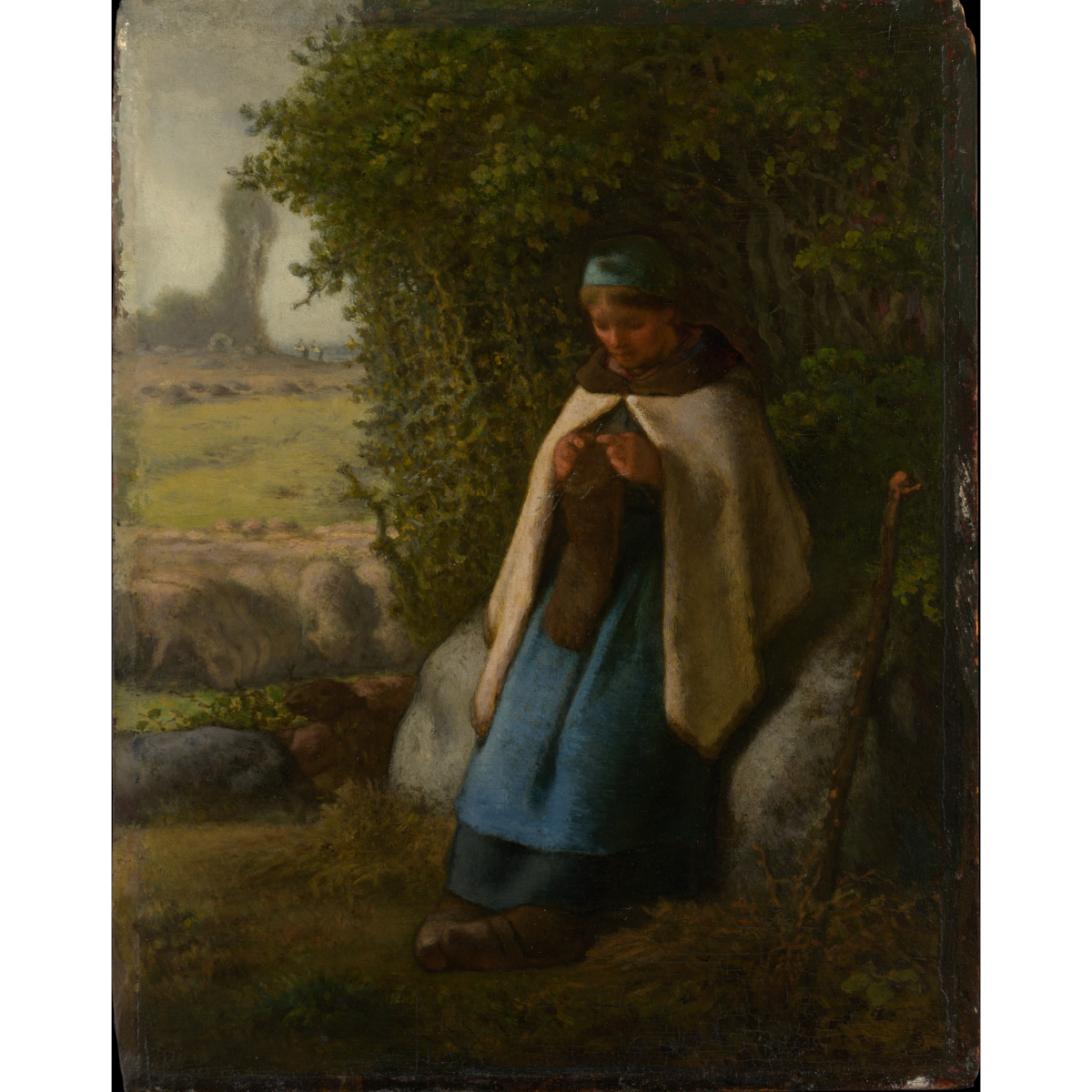Are you a knitter? Or perhaps you like to crochet? My maternal grandmother taught me how to crochet a chain when I was young, but that was about as advanced as I got. I do remember that she and my great-grandmother crocheted blankets—some they kept, some they gave to family, and some they sold.

I see that knitting and crocheting are still popular activities. Photos of yarn balls and knitted projects appear regularly in newsletters that I subscribe to and in my social media feed. A woman in the writing group I belong to (hi Cassandra!) crochets and/or writes at our write-ins. She’s currently working on an ambitious and amazing crochet project with a folklore theme. Seeing her hard at work on it each week, plus viewing progress photos of her project, jump-started my curiosity about knitting and folklore.
Knitting as a Welsh Cottage Industry
While researching folk life and domestic history for my creative writing, I’d read about knitting as a Welsh cottage industry in Domestic Life in Wales by S. Minwel Tibbott, so I started there. Unlike cooking and doing laundry, knitting was not an essential domestic skill. But it did form the basis of an important industry in rural Wales during the eighteenth and nineteenth centuries: knitting stockings. Minwel Tibbott writes:
Indeed, the domestic stocking-industry was a notable feature of the economic life of many districts whereby men and children joined forces with the womenfolk to knit stockings—not only for the use of their own families but also for vending.
Knitting stockings became a vital industry for many families throughout that time, and during famine periods “… saved many a family from starvation.” Minwel Tibbott notes that as a cottage industry, knitting stockings continued to support families economically up until the early twentieth century.
Between the financial benefits of knitting stockings and the lack of transportation in rural Wales during this time, women often knitted while they walked or performed other duties. Using a yarn hook in the shape of an “S,” women would attach the upper hook to the waistband of their apron, then hang a ball of yarn from the lower hook. In this way, both hands would be free for knitting while they walked, often with a basket on their back, traveling to market, tending to animals, or collecting peat.
The Noson Weu: A Night of Knitting and Folk Tales
But how might knitting connect with folklore, you ask? One answer: the noson weu (knitting night). The noson weu was a social tradition in rural Wales that combined knitting, song, and story (often in the form of folk tales). A family would invite neighbors and friends to their home in the evening, particularly during the winter months, to knit stockings and tell stories around the hearth. This sounds like a fun night to me!
These types of evenings were not always restricted to knitting. In The Welsh People, authors John Rhŷs and David Brynmor-Jones describe how other activities were included in these types of gatherings:
… some of the women would take up their knitting, some would peel rushes for rushlights, a servant-man would carve a wooden spoon or a ladle, and somebody would read to the company. When they grew tired of that, somebody would relate a story or propound riddles; and so things went on till all retired to rest.
It was a way for people to gather and interact while taking care of important tasks that contributed to their livelihood and well-being. But it was also an opportunity for folks to pass on story traditions. In Domestic Life in Wales, Minwel Tibbott explains the direct connection of the knitting night to folklore:
A good storyteller was always in great demand for these occasions and some of them had a great store of tales of the tylwyth teg (the fairies) and other folk tales. … At these gatherings song and story were focal, and the noson weu was instrumental in preserving these traditional forms of folklore.
“The Hidden Golden Chair”
So in the spirit of the noson weu, I thought it would be fun to share a folk tale of the type that might have been told during one of those cold, winter nights. Grab your knitting or preferred craft, set a warm drink at hand, and take a seat by the hearth. If the chairs are all taken you may have to sit on the floor or stand, but that’s fine—the more, the merrier.
Now this tale came to me by way of Elias Owen in his Welsh Folk-Lore: A Collection of the Folk-Tales and Legends of North Wales. But it is not his own story—it was told to him by Mrs. Mary Jones “a good many years since.” The tale is called “The Hidden Golden Chair,” and it takes place near the hamlet of Rhiwlas. I was excited to come across this folk tale because it includes knitting, yarn, and faeries. This is a summarized version—but I include several quotes from the book so that you may get a feel of the original storytelling. Let’s begin!
“There was once a beautiful girl, the daughter of poor hardworking parents, …” who took care of the family’s sheep. The time of year determined how often she would take the sheep to graze on the mountain, “… but she never went to the mountain without her knitting needles, and when looking after the sheep she was always knitting stockings, and she was so clever with her needles that she could knit as she walked along.”

One day, as she watched the sheep, she discovered a beautiful, golden chair. She went to it, but it was so massive, that she was unable to move it on her own. “She knew the Fairy-lore of her neighbourhood, and she understood that the Fairies had, by revealing the chair, intended it for her, but there she was on the wild mountain, far away from home, without anyone near to assist her in carrying it away.” She also knew that if she didn’t take possession of the chair right away, it would disappear, never to be seen again.
She decided that the best way to lay claim to the chair would be to attach one end of her yarn to the chair and the other end to her home. So after tying the yarn to the foot of the chair, she began walking toward home, unrolling the ball of yarn as she went.
“But long before she could reach her home the yarn in the ball was exhausted; she, however, tied it to the yarn in the stocking which she had been knitting, and again started towards her home, hoping to reach it before the yarn in the stocking would be finished, but she was doomed to disappointment, for that gave out before she could arrive at her father’s house.”
She had no more yarn with her, but she could see her home from where she was. She shouted for her parents, but they did not respond. “In her distress she fastened the end of the yarn to a large stone, and ran home as fast as she could. She told her parents what she had done, and all three proceeded immediately towards the stone to which the yarn had been tied, but they failed to discover it. The yarn, too, had disappeared.”
They searched for the rest of that day, and the next day as well, but the girl was never able to show her parents the spot where she had originally seen the golden chair. “It was believed by everybody that the Fairies had not only removed the golden chair, but also the yarn, and stone to which the yarn had been attached, but people thought that if the yarn had been long enough to reach from the chair to the girl’s home then the golden chair would have been hers for ever.”
Elias Owen offers us a bit of extra insight to the story. He explains that the golden chair may still be hidden up there in the mountain:
But it is, they say, no use anyone looking for it, as it is not to be got by searching, but it will be revealed, as if by accident, to those fated to possess it.
Listen to a Folk Tale: “The Fairy Widower”
I recently had the opportunity to be a guest reader for the Stories from the Hearth podcast, which is produced by The Folklore Podcast. Stories from the Hearth is a book-at-bedtime style podcast offering readings of folk and fairy tales.


I had so much fun reading and recording the Cornish folk tale, “The Fairy Widower.” I learned a lot about creating a recording and editing it. I’m grateful for the experience!
If you’d like to listen to the story I read, click on the button below, and it will take you to the Stories from the Hearth website. The story I narrated is “Story 11: The Fairy Widower,” but there are other tales to enjoy as well!
Art credit (featured image): Shepherdess Seated on a Rock by Jean-François Millet via The Metropolitan Museum of Art, licensed under CC0




